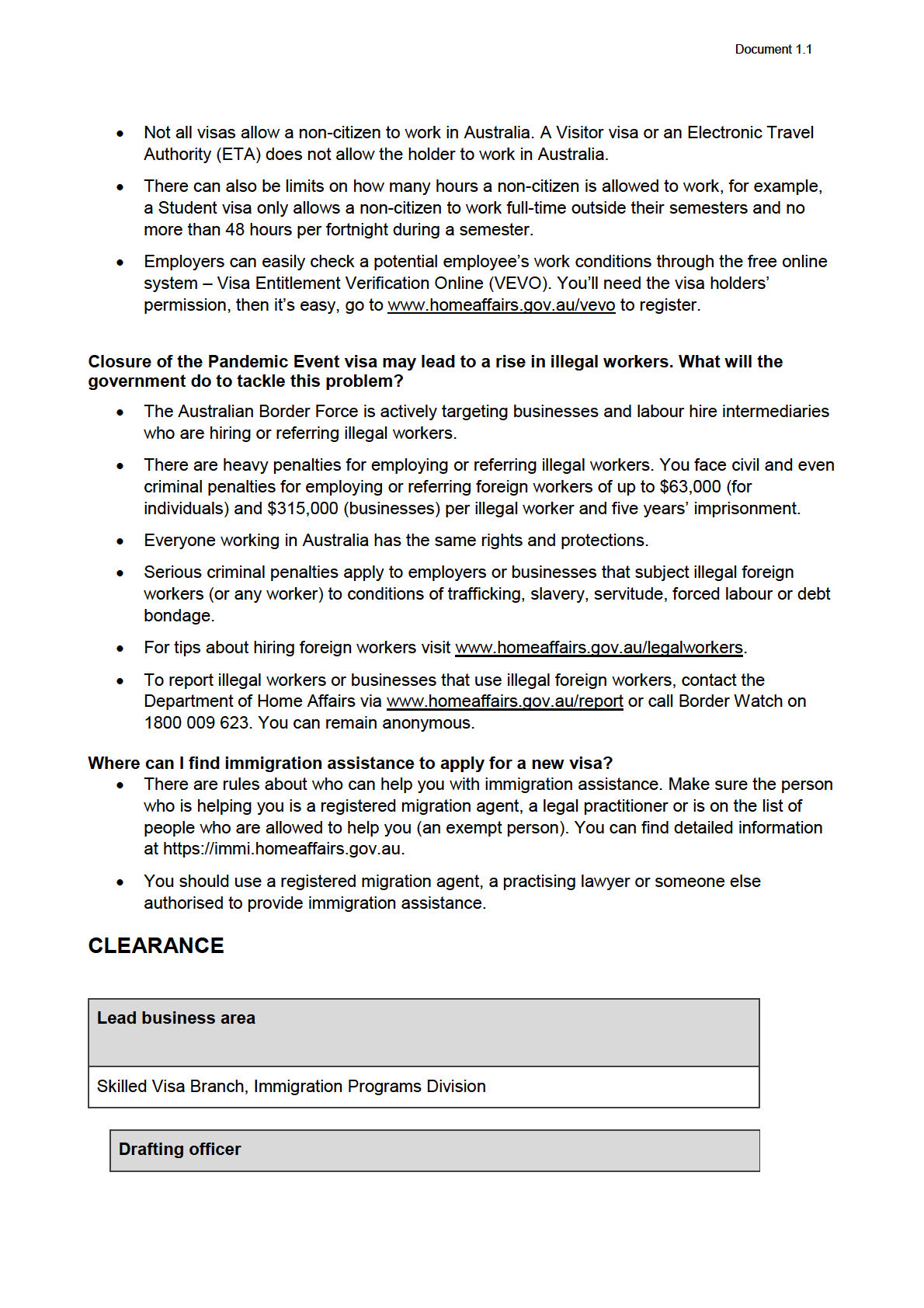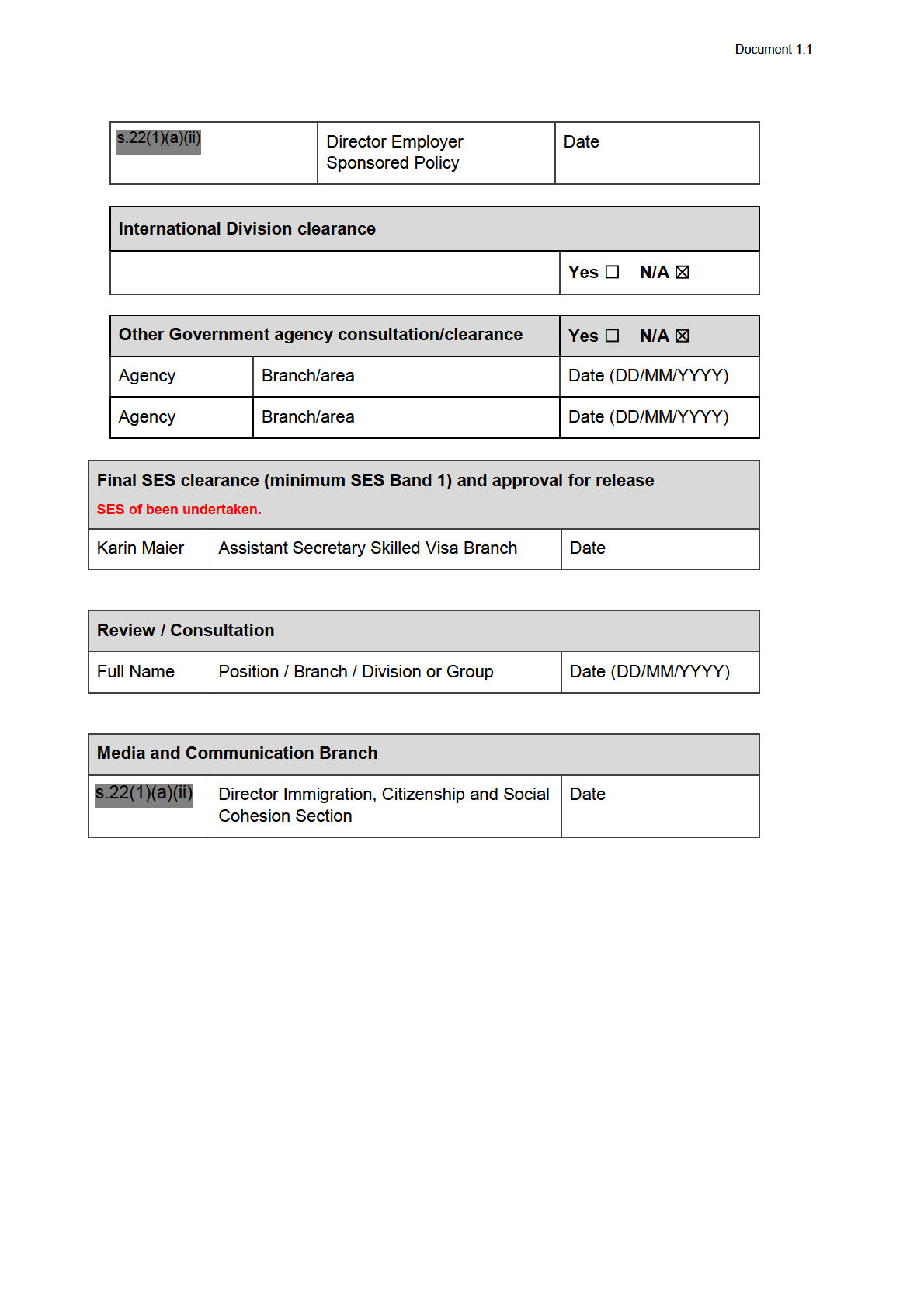
Document 1.1
nv
OFFICIAL:
TALKING POINTS
Subject
Final closure Pandemic Event visa
Date
16 January 2024
Type
Ministerial
ISSUE
These talking points have been developed to support media response in relation to the closure of
the, Temporary Activity visa (subclass 408)—Pandemic Event visa.
TALKING POINTS OFFICIAL
Attributable to a Departmental spokesperson:
• The Temporary Activity visa (subclass 408) Australian Government endorsed events
(COVID-19 Pandemic event) visa closed to new applicants from 2 September 2023, with
the final closure of the visa occurring on 1 February 2024.
• The Pandemic Event visa, which opened in April 2020, enabled temporary migrants to
lawfully remain in Australia while the border was closed. It also helped to provide a
temporary workforce to address labour shortages in critical sectors due to the pandemic.
• Given Australia’s borders are open and new migrant arrivals are replacing outgoing workers
the original intent of the visa is no longer relevant.
• Final closure of the Pandemic Event visa will contribute to a well-managed migration
system that better regulates visa pathways and normalises the flow of temporary migrants
in-and-out of Australia. It will help to reduce complexity in the visa system and remove a
COVID related product that is no longer fit for purpose.
• Extending the time before fully closing the visa has allowed existing Pandemic Event visa
holders to remain working in Australia and consider their options—during this period many
have made arrangements to apply for other visas or depart Australia before their current
visa expires.
• Visa holders should ensure they remain lawful if they wish to stay in Australia. Becoming
unlawful may impact their ability to visit Australia in the future. They can use the Visa
Entitlement Verification Online (VEVO) system to check their visa conditions and visa
validity.
• Persons who remain in Australia without a valid visa risk being detained and removed.
They may also incur a debt to the Australian Government for the cost of their removal.
• Employers of Pandemic Event visa holders should check what their employee’s plans are,
including whether their employees may need to apply for another visa or depart Australia.

Document 1.1
• It is an employer’s responsibility to ensure their overseas workers hold a valid visa with
work rights or risk significant penalties. Employers can use the Visa Entitlement Verification
Online (VEVO) system to check an overseas worker’s visa conditions and validity period.
• As at 31 December 2023, there were 104,467 Pandemic Event visa holders in Australia..
On background OFFICIAL (for use in reporting, not for attribution):
(The talking points in this section wil be provided to the journalist on background and should
support the formal response. This section will not be attributable to a Department spokesperson but
should not include anything above OFFICIAL).
If asked:
Why are you closing the Pandemic Event visa and forcing Pandemic Event visa holders
who helped Australia through the pandemic to leave?
• The original intent of the Pandemic Event visa was to ensure people unable to depart
Australia due to COVID-19-related border closures remained lawful. It also helped to
address labour shortages in critical sectors due to the pandemic.
• It is now time for visa holders to regularise their visa status and apply for a visa that is
designed for their intended purpose of stay or make arrangements to depart.
• Those who have overstayed their visa are strongly encouraged to contact the Department
as soon as practicable via the Status Resolution Service online at
www.homeaffairs.gov.au/csrs or phone 131 881 (Monday to Friday 9 am to 5 pm).
• The visa’s closure is also a part of the Government’s strategy to tackle exploitation of
migrant workers. Students make up about one third of Pandemic Event visa holders.
• The international education industry has raised concerns that an increasing number of
former student visa holders, such as those who enrolled in English Language Intensive
Courses for Overseas Students, are using the Pandemic Event visa to work full time rather
than study. This situation leaves these visa holders open to potential exploitation.
Wil any special arrangements be in place for this cohort to access permanent residence?
• No. Approximately 40 per cent of Pandemic Event visa holders are earning above the
Temporary Skil ed Migration Income Threshold (TSMIT) of $70,000. They may be eligible
for a skil ed visa to remain in Australia on a pathway to permanent residence. Individuals
may also be eligible for permanent family visas.
o Between 1 August 2023 and 31 December 2023:
Close to 5,300 subclass 408 holders (mostly made up of Pandemic Event)
1have transitioned to Skil ed Category visas, including Employer Sponsored,
Skil ed Independent, State/Territory Nominated and Regional Skil ed.
More than 940 subclass 408 holders (mostly made up of Pandemic Event)
have transitioned to Family stream visas (primarily Partner)
More than 830 Pandemic Event holders have transitioned to Student visas
1 In the context of the Pandemic Event visa cohort, there are reporting limitations across different visa subclasses the group is utilising. When referring to
408 visa holders this includes all former subclass 408 visa holders, including the Pandemic Event visa, which accounted for approximately 90% of all
subclass 408 visa holders in 2023. When referring to Pandemic Event visas, this refers to the singular event within the 408 visa program.

Document 1.1
Close to 2,000 Pandemic Event holders have transitioned to Temporary Skil
Shortage Visas and;
More than 3,100 Pandemic Event holders have transitioned to Temporary
Resident (other employment) visas, including Pacific Australia Labour
Mobility Scheme and Graduate Work.
How many Pandemic Event visa holders wil miss out on being able to re-apply for another
Pandemic Event visa once it fully closes on 1 February 2024?
• Approximately 95,000 people hold a Pandemic Event visa that expires after February 2024
and wil not be eligible to make a further application once the visa closes.
o These visas wil expire gradually over the next 24 months, including a group of
around 12,000 Temporary Graduate visa holders whose visas wil expire in 2025.
This gradual reduction in Pandemic Event visa holders onshore wil not cause a
sudden exodus of workers in Australia, and may be replaced by incoming migrant
workers.
o Visa holders should ensure they remain lawful if they wish to stay in Australia.
Becoming unlawful may impact their ability to visit Australia in the future. They can
use the Visa Entitlement Verification Online (VEVO) system to check their visa
conditions and visa validity.
o Visa holders who cannot resolve their immigration status prior to the cessation of
their Pandemic Event visa are encouraged to contact the Department’s Status
Resolution Service and may be eligible for assistance in returning home.
o Pandemic Event visa holders who remain in Australia without a valid visa risk being
detained and removed by the Australian Border Force. They may also incur a debt
to the Australian Government for the cost of your removal.
What are the main types of visa holders to have been granted Pandemic Event visa?
• The top four visa holder types that use the Pandemic Event visa are Students (500),
Temporary Graduate Visa (TGV) (485), Working Holiday Makers (417), and Temporary
Activity visa holders (408). Cumulatively, grants to these four types of visa holders have
accounted for nearly 80 percent (79.45%) of all grants.
Students
• Students who complete their studies and wish to remain in Australia may be eligible for a
range of visas, including the Temporary Graduate visa.
• Closure ensures that students cannot use the Pandemic Event visa as a backdoor into
Australia’s labour market and that they are genuinely in Australia to study.
Temporary Graduates
• Temporary graduates who have skil s and qualifications that Australia needs have a
number of visa options, including skil ed visas, to remain in Australia.
• The Australian Government implemented pathways to residence for all skil ed sponsored
workers on 25 November 2023. Graduates with the skil s Australia needs and employers
wil ing to sponsor them are encouraged to investigate these options.

Document 1.1
Pacific Australia Labour Mobility (PALM) scheme
• From commencement of the Pandemic Event Visa to 31 December 2023, 17,301 COVID-
19 Pandemic Event visa applications have been received and 14,921 visas granted to
former PALM visa holders.
• Closure of the Pandemic Event visa ensures the PALM program returns to its original intent
of circular mobility.
• By implementing a staged closure, the Government is giving more time for employers to
plan for the departure of PALM workers and recruit new workers.
o This does not mean workers wil be required to depart Australia at the same
time—these visas wil expire gradually over the next 12 months and not cause a
sudden exodus of workers. Recruitment wil ensure these workers can be
replaced as they depart.
Working Holiday Makers
• WHMs may be eligible for a further WHM visa if they meet specified work and other
eligibility requirements.
• For some, the Pandemic Event visa may have effectively replaced their WHM visa as a nil-
VAC option to extend their stay.
Skilled
• From 30 June 2020 until 31 December 2023, 5,964 visa holders have transitioned from a
Pandemic Event visa to a Temporary Skil Shortage visa.
o A further 633 former Pandemic Event holders have outstanding Temporary Skil
Shortage applications, to which they hold associated Bridging Visas.
What countries are Pandemic Event visa holders mostly from?
• Indian citizens have made up the largest cohort of visa holders since inception, with more
than 32,200 visa grants. Followed by Nepal (more than 21,300), Colombia (more than
14,600), China (more than 14,200) and the United Kingdom (14,000).
What happens to Pandemic Event visa holders who apply for protection visas to remain
lawfully in Australia?
• Protection visas are for people currently facing a real risk of suffering significant harm if
returned to their home country and are in need of Australia’s protection.
• If you apply for protection and you are refused, it is unlikely you wil be able to apply for
another visa while stil in Australia.
• You can withdraw (or delete) your application at any time and apply for a visa that meets
your circumstances.
• For more information on Australia’s protection obligations visit: Protection visas (onshore)
(homeaffairs.gov.au)
What responsibilities does an employer have when hiring a non-citizen?
• Before hiring a non-citizen, it’s the employers responsibility to check they can work legally
in Australia.
• Only Australian citizens, permanent residents and New Zealand nationals holding Special
Category (subclass 444) visas have an unrestricted right to work in Australia.











